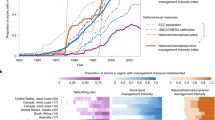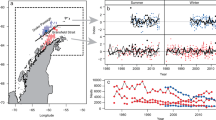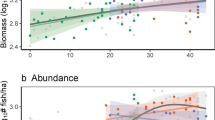Abstract
Over-exploitation and subsequent collapse of marine fishes has focused attention on the ability of affected populations to recover to former abundance levels1,2,3 and on the degree to which their persistence is threatened by extinction4,5. Although potential for recovery has been assessed indirectly1, actual changes in population size following long-term declines have not been examined empirically. Here I show that there is very little evidence for rapid recovery from prolonged declines, in contrast to the perception that marine fishes are highly resilient to large population reductions6,7. With the possible exception of herring and related species that mature early in life and are fished with highly selective equipment, my analysis of 90 stocks reveals that many gadids (for example, cod, haddock) and other non-clupeids (for example, flatfishes) have experienced little, if any, recovery as much as 15 years after 45–99% reductions in reproductive biomass. Although the effects of overfishing on single species may generally be reversible1, the actual time required for recovery appears to be considerable. To exempt marine fishes from existing criteria used to assign extinction risk6,7 would be inconsistent with precautionary approaches to fisheries management and the conservation of marine biodiversity.
This is a preview of subscription content, access via your institution
Access options
Subscribe to this journal
Receive 51 print issues and online access
$199.00 per year
only $3.90 per issue
Buy this article
- Purchase on Springer Link
- Instant access to full article PDF
Prices may be subject to local taxes which are calculated during checkout



Similar content being viewed by others
References
Myers, R. A., Barrowman, N. J., Hutchings, J. A. & Rosenberg, A. A. Population dynamics of exploited fish stocks at low population levels. Science 269, 1106–1108 ( 1995).
Cook, R. M., Sinclair, A. & Stefànsson, G. Potential collapse of North Sea cod stocks. Nature 385, 521–522 (1997).
Leirmann, M. & Hilborn, R. Depensation in fish stocks in a hierarchic Bayesian meta-analysis. Can. J. Fish. Aquat. Sci. 54, 1976–1984 (1997).
The International Union for Conservation of Nature (IUCN). IUCN Red List of Threatened Animals (IUCN, London, 1996).
Carlton, J. T., Geller, J. B., Reaka-Kudla, M. J. & Norse, E. A. Historical extinctions in the sea. Annu. Rev. Ecol. Syst. 30, 515–538 (1999).
Hudson, E. & Mace, G. (eds) Marine Fish and the IUCN Red List of Threatened Animals (Zoological Society of London, London, 1996).
Musick, J. A. Criteria to define extinction risk in marine fishes. Fisheries 24, 6–12 (1999 ).
Casey, J. M. & Myers, R. A. Near extinction of a large, widely distributed fish. Science 228, 690– 692 (1998).
Hutchings, J. A. & Myers, R. A. What can be learned from the collapse of a renewable resource? Atlantic cod, Gadus morhua, of Newfoundland and Labrador. Can. J. Fish. Aquat. Sci. 51, 2126–2146 (1994).
Myers, R. A., Hutchings, J. A. & Barrowman, N. J. Hypotheses for the decline of cod in the North Atlantic. Mar. Ecol. Prog. Ser. 138, 293– 308 (1996).
Sinclair, A. F. & Murawski, S. A. in Northwest Atlantic Groundfish: Perspectives on a Fishery Collapse (eds Boreman, J., Nakashima, B. S., Wilson, J. A. & Kendall, R. L.) 71– 93 (American Fisheries Society, Bethesda, Maryland, 1997).
Shank, C. C. The Committee on the Status of Endangered Wildlife in Canada (COSEWIC): a 21-year retrospective. Can. Field-Nat. 113, 318–341 (1999).
IUCN Species Survival Commission. IUCN Red List Categories (IUCN, Cambridge, 1999).
Campbell, R. R. Rare and endangered fishes and marine mammals of Canada: COSEWIC Fish and Marine Mammal Subcommittee status reports: X. Can. Field-Nat. 110, 454–461 (1996).
Froese, R. & Pauly, D. (eds) FishBase 99 [online] (cited 18 Feb 00) 〈http:www.fishbase.org〉 (1999).
Roff, D. A. The Evolution of Life Histories: Theory and Analysis (Chapman & Hall, New York, 1992).
Lande, R. Risks of population extinction from demographic and environmental stochasticity and random catastrophes. Am. Nat. 142, 911 –927 (1993).
Sæther, B. -E., Engen, S., Swenson, J. E., Bakke, Ø. & Sandegren, F. Assessing the viability of Scandinavian brown bear, Ursus arctos, populations: the effects of uncertain parameter estimates. Oikos 83, 403– 416 (1998).
Alverson, D. L., Freeberg, M. H., Murawski, S. A. & Pope, J. G. A global assessment of fisheries bycatch and discards. FAO Fish. Tech. Pap. 339, 1–233 ( 1994).
Hilborn, R. & Walters, C. Quantitative Fisheries Stock Assessment. (Chapman & Hall, New York, 1992).
Hutchings, J. A. & Myers, R. A. in The North Atlantic Fisheries: Successes, Failures, and Challenges (eds Arnason, R. & Felt, L.) 38–93 (Institute of Island Studies, Charlottetown, Canada, 1995).
Smith, T. D. Scaling Fisheries: The Science of Measuring the Effects of Fishing, 1855–1955 (Cambridge Univ. Press, Cambridge, UK, 1994).
Pauly, D., Christensen, V., Dalsgaard, J., Froese, R. & Torres, F. Fishing down marine food webs. Science 279, 860–863 ( 1997).
Jennings, S. & Kaiser, M. J. The effects of fishing on marine ecosystems. Adv. Mar. Biol. 34, 201– 352 (1998).
Acknowledgements
This work was supported by a Natural Sciences and Engineering Research Council of Canada Research Grant. I thank B. Hall, I. McLaren, J. Shepherd and D. Swain for their helpful comments on previous versions of the manuscript.
Author information
Authors and Affiliations
Corresponding author
Rights and permissions
About this article
Cite this article
Hutchings, J. Collapse and recovery of marine fishes. Nature 406, 882–885 (2000). https://doi.org/10.1038/35022565
Received:
Accepted:
Issue Date:
DOI: https://doi.org/10.1038/35022565
This article is cited by
-
Genetic analyses reveal panmixia in Indian waters and population subdivision across Indian Ocean and Indo-Malay Archipelago for Decapterus russelli
Scientific Reports (2023)
-
The bioeconomic paradox of market-based invasive species harvest: a case study of the commercial lionfish fishery
Biological Invasions (2023)
-
Aquaculture in the Ancient World: Ecosystem Engineering, Domesticated Landscapes, and the First Blue Revolution
Journal of Archaeological Research (2023)
-
On the independence between clupeid stocks and their recruitment
Fisheries Science (2023)
-
Addressing the dichotomy of fishing and climate in fishery management with the FishClim model
Communications Biology (2022)
Comments
By submitting a comment you agree to abide by our Terms and Community Guidelines. If you find something abusive or that does not comply with our terms or guidelines please flag it as inappropriate.



